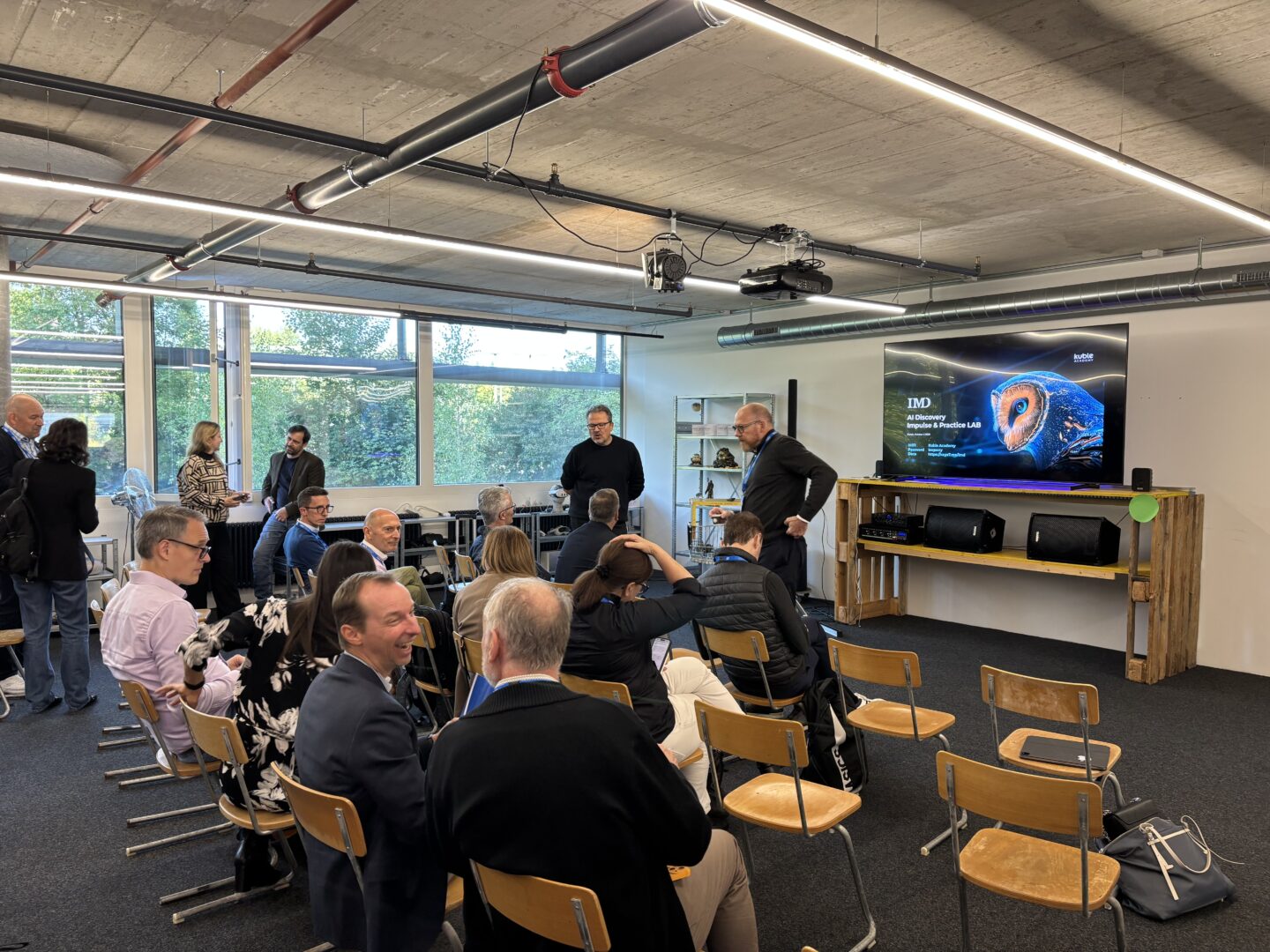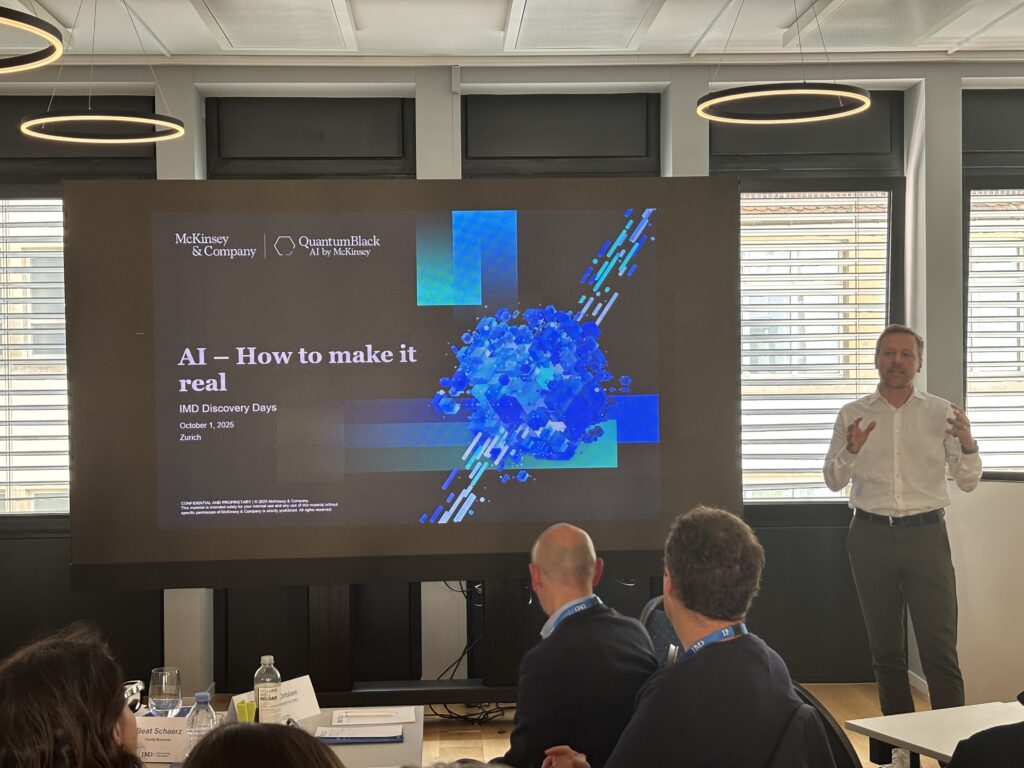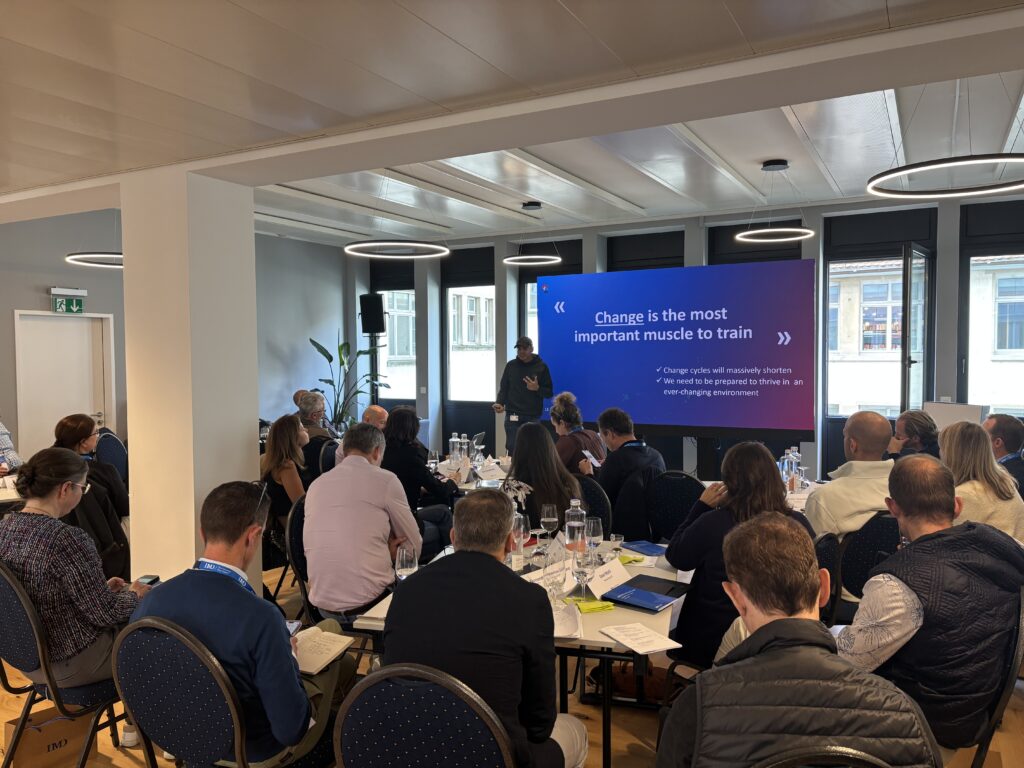
The three-day event, Unleash Your AI Potential, chaired by Liana Logiurato, non-executive director at Intesa Sanpaolo and board member of the IMD Alumni Association, brought together industry leaders and academic experts to explore how the most successful companies are shifting their focus from saving money to making money with AI, while also ensuring transparent governance and building a culture that supports the technology’s use across the organization.
AI driving revenue growth, not just cost reduction
A central theme emerged early in the program: the conversation around AI must fundamentally shift from cost-cutting to revenue generation and market acceleration.
Omair Ahmed Khan, EVP of Data, Analytics & AI at Swisscom, Switzerland, explained, “Leaders appreciate when the AI narrative focuses on time to market and revenue, not just cost-cutting. Today, in most companies, you have a backlog of things you can’t do. The best exercise is to prioritize what you do and don’t do. If you have 10 things to do, but can only do two, with AI, you might be able to do four instead. This decreases your time to market and increases revenue potential. AI should also be a story of ‘more’ revenue – not just a story of ‘less’ costs.”
The economic stakes are substantial. Speakers highlighted that 30% of activities could be automated by 2030, potentially generating $4.4tn in global profits. However, research shows that while 80% of companies implement AI in at least one function, only 20% report material contributions – underscoring the gap between deployment and value creation.
The key to bridging this gap lies in how organizations approach implementation. Rather than treating AI as an add-on to existing processes, successful organizations are fundamentally reimagining their operations in the context of AI. As one speaker noted, less than 5% of companies have derived significant value from AI, primarily due to a lack of foundational data and context. Bad data, poor context – bad AI.

The shift toward agentic AI systems
Throughout the event, alumni explored how AI is evolving beyond simple chatbots and copilots that assist humans toward more sophisticated agentic systems that can autonomously manage entire workflows and complete complex tasks. Daniel S Ehmann, Global Tech Lead of Agentic AI Applications at IBM, stated, “It’s nice to deploy chatbots and copilots, but that’s only scratching the surface of AI. Its value is in deep integration within specific applications.”
Real-world examples shared during the sessions demonstrated how multi-agent systems can deliver value – from slashing regulatory reporting costs to winning new clients by using an AI-powered end-to-end sales approach, and substantially increasing the proportion of queries solved and closed by AI without human intervention in customer service operations.
The discussion highlighted how specialized AI agents working together can outperform single-agent systems, with applications spanning regulatory compliance to fraud detection.
The commoditization of AI and its economic impact
A particularly striking theme that resonated across the three days centered on how rapidly AI is becoming commoditized, with profound implications for business models and competitive advantage.
Yariv Adan, General Partner at Ellipsis Venture, Switzerland, noted, “The cost of AI writing a million lines of code – a very complex piece of logic – is about $1. That is like the cost of a napkin when you order coffee. Just as you don’t save the napkin for the next time you order coffee, it will be the same for code. We just throw it away. It’s cheaper and faster to generate the same code again from scratch, rather than try to maintain it and save it.”
The implications of this extend beyond individual lines of code to entire business models. Traditional SaaS companies that depend on licensing software face disruption as the economics shift from scarce, expensive software development to abundant, nearly free code generation.
This commoditization is transforming the software industry and beyond, with the marginal cost of data creation approaching zero. The shift creates both opportunities and challenges: while it democratizes access to powerful capabilities, it also means traditional ‘moats’ to competition are eroding rapidly. Success increasingly depends on data quality, domain expertise, and the ability to integrate AI deeply into specific applications rather than surface-level deployments.
The World Economic Forum’s prediction that 92 million jobs will be displaced by 2030, but 170 million new jobs will be created, illustrates the transformation’s scale. Vincenzo De Rosa, Lead Director of AI, Europe West at EY, Switzerland, captured the urgency. “AI is a giant wave: you either learn to surf it, or you’ll be swallowed by it.”

Transparency, governance, and the human factor
The event addressed critical questions around AI transparency and governance. In the context of AI model development, Andreas Krause, Professor at ETH Zurich, Switzerland, highlighted the challenge of models being developed “behind closed doors” by large tech companies. He argued that these models, which embody significant aspects of our culture and society, are primarily created in private settings.
“This lack of transparency raises important challenges, as the models represent and potentially shape societal knowledge and understanding,” he said. “This is a key issue, which is why the Swiss AI Initiative aims to develop more transparent and open AI models, like the Apertus language model, which provides full transparency about its training data, processes, and model details.”
Participants also took part in an AI-related crisis management exercise, led by Elena De Ritis, Associate Partner and Threat Management Leader at DACH IBM, Switzerland, that illustrated how fast and multifaceted an AI-enhanced cyber hack can be. It demonstrated the importance of preparation and training for emerging cybersecurity challenges and the potential to fight fire with fire by deploying defensive AI agents to help fend off cyberattacks. A key mantra to protect a company’s investment in AI was “secure the data, secure the model, and secure the usage.”
Culture and capability: the foundations of AI success
However, the most persistent theme across the three days was that AI transformation is fundamentally about mindset, not just technology. Organizations must reimagine their processes, develop new capabilities, and cultivate a culture of continuous learning. Success requires C-level buy-in, talent upskilling across all levels, and integrated operating models where business and technology work closely together.
Keynote speaker Andreas Ess, QuantumBlack and McKinsey, Partner commented: “Rewiring for the age of digital and AI requires a business-led digital roadmap. But before broad adoption and scaling, we recommend starting with one business area before transforming the full business. It helps you focus, and you’re allocating real resources to then unleash synergies. Importantly, it’s never just tech: underlying technology, data and platforms – and also the talent that you deploy and the people that you touch go hand in hand.”
The human role remains crucial: exercising critical thinking, providing oversight, and ensuring AI systems meet necessary standards. Alumni discussed how organizations must build the ‘change muscle’ – developing employees’ ability to rapidly learn, unlearn, and adapt. In an era of deepfakes and AI-generated misinformation, maintaining and proving trustworthiness to both external stakeholders and employees is a critical challenge for organizations.
Liana Logiurato, who hosted the meeting, commented, “The course has generated essential wake-up calls and provided the key building blocks to deal with a revolution impacting people, businesses, industries, and society. AI is not about technology, but rather embracing change with the right attitude and a growth mindset, imagining the ‘art of the possible.’ We did this with our distinctive IMD spirit of creating impact via sharing experiences and learning together.”
As the three-day event concluded, the message was unequivocal: AI adoption is no longer optional. The technology is reshaping industries, business, and society at an unprecedented speed, and organizations face a stark choice between adapting quickly or falling behind competitors who do.
AI use cases with proven results
A range of AI use cases was shared by presenters, including:
Regulatory reporting and compliance
Pharmaceutical companies must submit extensive documentation to regulators proving drug safety and efficacy before market approval – a process that directly impacts revenue timing. AI-generated regulatory reports using a team of specialized agents for writing, checking completeness, and verifying correctness reduced the cost of generating the reports by 70% and improved the drug’s time-to-market by 100 days. Regulatory reporting is an ideal candidate for the application of AI because language models are strong at producing text; it’s a laborious low-added-value administrative burden that companies are trying to streamline and needs to be done on a recurring basis – and on a global scale – for each new drug.
Fraud detection
AI rapidly and reliably identifies and flags unusual modifications in transactions, invoices, employee expense reports, warranty claims, and medical claims – producing significant cost savings. For example, an insurance company deployed computer vision AI to address a persistent problem: garages were overcharging insurers for car repairs. The system assesses actual vehicle damage, compares it against garage cost estimates, and highlights potential billing ‘leakage’ that should not be paid. This approach delivers dual benefits – financial savings by preventing overpayment, and sustainability gains by encouraging repairs instead of full replacements (such as for glass claims). The example demonstrates how AI can objectively analyze damage and detect inflated repair claims by comparing physical evidence to proposed costs.
Sales growth acceleration
AI analyzes internal and external data to recommend target sectors, clients, products, and services, then generates tailored reports to help sales teams prepare for pitches. One such AI-generated pitch to a new client generated €90m ($105.6m) in annual revenue with six-times ROI, prompting top management to also start using AI recommendations to allocate investments in corporate business development.
Operations optimization through AI design and testing
AI is being applied to optimize operational efficiency through advanced design and a rapid series of test simulations. In trucking logistics, this AI-powered aerodynamic modeling for vehicles reduced drag by 2% – a modest-sounding improvement – but one that translates into substantial fuel savings and reduced carbon emissions across large fleets operating millions of miles annually.


